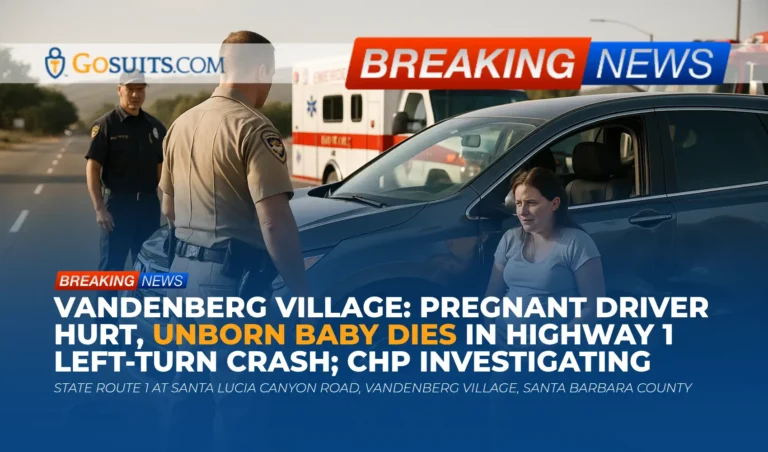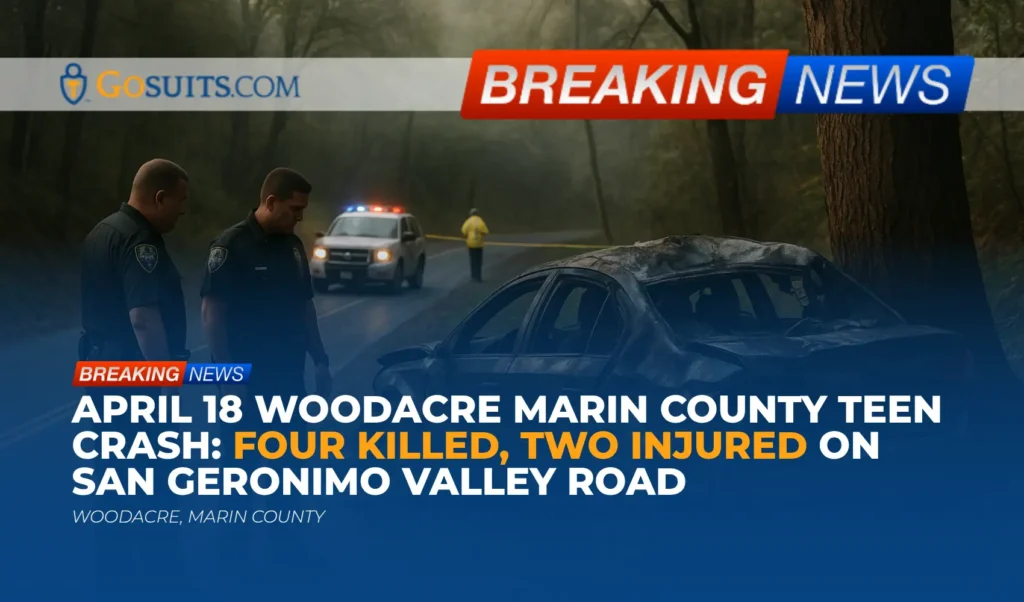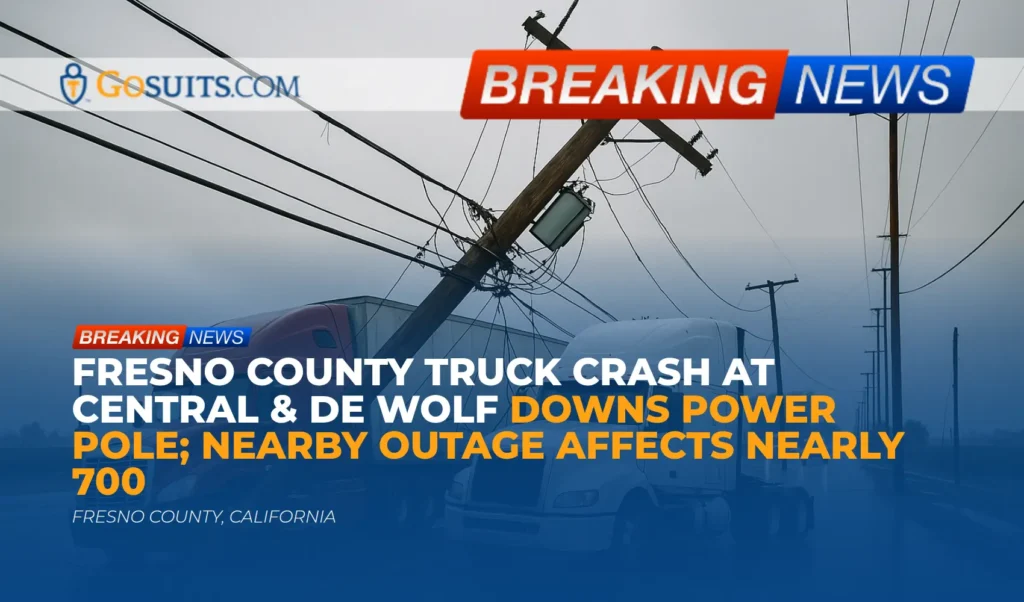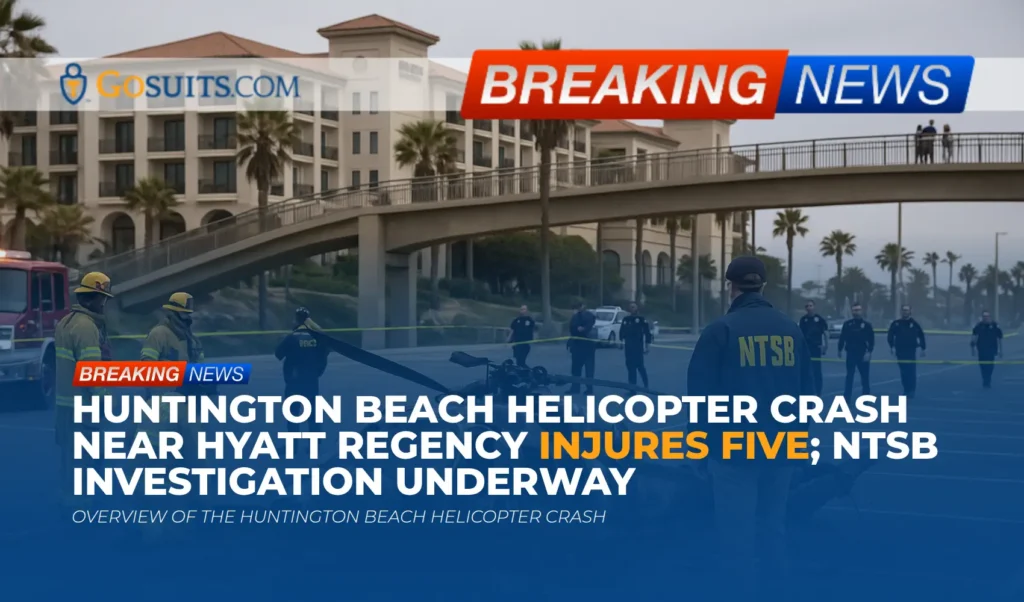- Incident overview and what is known
- Where and when it happened
- Emergency response and ongoing investigation
- Legal context in California: left turns, right-of-way, and safe movement
- Potential civil liability themes often examined in similar crashes
- Special considerations when a pregnancy is lost after a crash in California
- Evidence to preserve and why timing matters
- How to obtain official records and support
- Insurance issues after a serious collision
- Key California timelines and deadlines
- Community safety context for intersections and left-turn crashes
- Commentary from Gosuits Vandenberg Village, California Personal Injury Attorney
- Action steps that matter now
Incident overview and what is known
Authorities reported a two-vehicle collision on State Route 1 at Santa Lucia Canyon Road near Vandenberg Village that occurred around 5:30 p.m. on Tuesday, October 7. According to information shared publicly, a northbound 2018 Honda CR‑V slowed to turn left off Highway 1 onto Santa Lucia Canyon Road. While crossing the southbound lanes, the Honda’s right side was struck by a 2021 Lexus traveling southbound.
Emergency crews from Santa Barbara County Fire, Lompoc Fire, AMR, the California Highway Patrol, and CalSTAR responded at approximately 5:43 p.m. Two patients were transported to Marian Medical Center. The Honda’s driver, who was pregnant, sustained major injuries and was airlifted; tragically, the unborn baby was later pronounced deceased due to injuries from the crash, as reported by the California Highway Patrol. The other driver reportedly suffered minor injuries.
The CHP has stated the investigation remains open and asked anyone with information to contact the Buellton Area CHP office at (805) 691‑6160.
Where and when it happened
The collision took place on State Route 1 at the intersection with Santa Lucia Canyon Road, in the vicinity of Vandenberg Village in northern Santa Barbara County. The reported time was about 5:30 p.m. on Tuesday, October 7. This is a well-traveled corridor serving local communities and traffic between Lompoc-area destinations and points along Highway 1.
Emergency response and ongoing investigation
First responders arrived within minutes. CalSTAR air transport was utilized due to the severity of injuries to the pregnant driver. Both involved drivers were transported to Marian Medical Center. These steps reflect common protocols for serious injury collisions, especially those with potential complications related to pregnancy.
As the investigation is ongoing, the CHP will typically document scene evidence, interview drivers and witnesses, and assess contributing factors such as visibility, traffic controls, lighting conditions, speed, vehicle movement, and whether any mechanical issues played a role. Final determinations about contributing factors and any citations, if any, are made only after evidence is collected and reviewed.
Legal context in California: left turns, right-of-way, and safe movement
California drivers have a general duty to operate their vehicles with reasonable care. Several California Vehicle Code provisions are often relevant in angle and left-turn crashes:
- Left turns must yield to oncoming traffic. California Vehicle Code section 21801 requires drivers intending to turn left to yield the right-of-way to oncoming vehicles that are close enough to pose an immediate hazard until the turn can be made with reasonable safety. See the statute at leginfo.legislature.ca.gov.
- Safe movement requirement. Even where right-of-way is granted, every driver must make movements when it is safe to do so and use due care under the circumstances. This general duty of care is evaluated by investigators and, where applicable, by courts using California negligence standards. Official civil jury instructions discuss comparative fault concepts when multiple drivers may share responsibility. See the Judicial Council of California Civil Jury Instructions (CACI), which include instructions on comparative fault, at the California Courts website: courts.ca.gov.
Because the CHP investigation remains open, no definitive allocation of fault has been made public. The references above are provided to help readers understand the types of rules that often guide analysis in similar situations across California.
Potential civil liability themes often examined in similar crashes
In civil personal-injury cases arising from vehicle collisions, several avenues are commonly evaluated. The items below are general and not specific conclusions about this event.
- Driver negligence. Investigators consider whether either driver failed to yield, was inattentive, was traveling at an unsafe speed for conditions, or made a turn that could not be completed safely. Evidence often includes skid marks, vehicle damage profiles, point of impact, traffic signal or sign data, and witness accounts.
- Comparative fault. California uses comparative fault principles. If more than one party shares responsibility, fault may be apportioned by percentages. This framework is reflected in the state’s civil jury instructions noted above from the California Courts.
- Vehicle issues. In some cases, brake failures, steering problems, lighting defects, or airbag performance may be assessed. Determinations about automotive defects generally require technical inspection and are highly fact specific.
- Roadway and intersection conditions. Investigations sometimes examine whether sight lines, lane markings, signage, or signal timing contributed. Where a claim involves a public roadway in a dangerous condition, California Government Code section 835 outlines when a public entity may be liable if a hazardous condition was a substantial factor and other requirements are met. The statute can be viewed at leginfo.legislature.ca.gov.
These evaluations depend on detailed evidence. It is common for conclusions to evolve as additional information, measurements, and expert analyses become available.
Special considerations when a pregnancy is lost after a crash in California
Collisions that cause serious injuries during pregnancy involve unique medical and legal considerations. Families understandably have questions about what the civil legal system may address when a pregnancy is lost in a motor vehicle crash.
In California, wrongful death claims are governed by the Code of Civil Procedure. The statute identifies who may bring a wrongful death action and generally contemplates the death of a person. See Code of Civil Procedure section 377.60 at leginfo.legislature.ca.gov. California courts have historically interpreted this framework to mean a separate wrongful death action is generally not available for the death of a fetus that was not born alive. This is a sensitive and technical area, and outcomes turn on specific facts and the current state of the law.
Even where a separate wrongful death claim for an unborn baby is not recognized, the injured pregnant person may still seek civil recovery for their own injuries and losses. That may include physical injuries, medical expenses, and the profound emotional distress associated with a traumatic pregnancy loss. The appropriate scope of damages depends on the evidence and applicable law.
Families dealing with such loss often benefit from trauma-informed care and supportive services. While this article cannot provide medical guidance, public resources exist to help with emotional support and grief. For confidential support, the federal SAMHSA National Helpline is available at 1‑800‑662‑HELP (4357) and provides free, confidential referrals 24 hours a day. Information about this service is available at samhsa.gov.
Evidence to preserve and why timing matters
Serious collisions are best understood through careful evidence collection. Preserving evidence early helps ensure a fair and accurate assessment of what occurred.
- Vehicles. Retain the involved vehicles in their post-collision state when possible. Modern vehicles often contain electronic data recorders that may store pre-impact speed, throttle, brake, and airbag deployment data. Preservation requires prompt coordination to avoid loss of data due to repairs, salvage, or routine storage policies.
- Scene documentation. Photographs or video of the intersection, final rest positions, debris fields, gouge marks, and sightlines can be important. Lighting conditions at the approximate time of day and weather should be documented as close in time as possible.
- Witness information. Names, contact details, and quick written accounts from witnesses can fade with time. Promptly collecting this information can make a substantial difference.
- Medical documentation. Keep all records related to emergency care, hospitalization, imaging, and follow-up treatment. For pregnancy-related trauma, obstetric and maternal-fetal medicine records may be central to understanding causation and damages. Individuals have a right to access their health information under federal law. See the U.S. Department of Health and Human Services guidance on the HIPAA Right of Access at hhs.gov.
- Official reports. Obtain the CHP collision report and any supplemental diagrams or photographs when they become available. In California, collision reports are typically available to parties of interest, which is addressed in Vehicle Code section 20012. The statute can be read at leginfo.legislature.ca.gov.
If an insurance claim is contemplated, consider consulting a qualified attorney before providing recorded statements. What is said to an insurer may be used later in ways that affect liability determinations and damage evaluations. A free consultation can help clarify rights and risks before engaging with claim handlers.
How to obtain official records and support
Several public agencies can provide records or information that may help families understand what happened and navigate practical steps.
California Highway Patrol collision report
The CHP prepares the primary collision report for state highway incidents. Parties of interest can request a copy by submitting the appropriate request form, commonly known as CHP 190, to the investigating area office. Guidance on requesting a CHP collision report is available from the California Highway Patrol at chp.ca.gov. The Buellton Area CHP office number, as shared publicly for this incident, is (805) 691‑6160.
Coroner involvement and reports
In California, county coroners have statutory responsibilities to investigate certain deaths, including those related to accidents. Government Code section 27491 outlines these duties. See the statute at leginfo.legislature.ca.gov.
Procedures and eligibility to receive coroner reports vary by county. In Santa Barbara County, the Sheriff-Coroner is the relevant office. Families generally can inquire about investigative status, availability of reports, and processes for requesting documents such as the coroner’s report or autopsy findings if one was conducted. Contact information is typically available from the county sheriff-coroner’s office directory.

Vital records related to fetal loss
California’s Department of Public Health oversees vital records, including birth and death registration. Health care providers and local registrars manage fetal death registration as required by state law. For statewide information about vital records processes and where to request certified copies, see the California Department of Public Health Vital Records page at cdph.ca.gov.
Medical records
Individuals are entitled to access their medical records. Federal guidance from the U.S. Department of Health and Human Services explains timelines and permissible fees for obtaining copies. Details are available at hhs.gov. Hospitals can typically provide instructions through their Health Information Management or Medical Records department.
Witness statements and personal documentation
Maintain a journal describing symptoms, pain levels, sleep disturbances, and emotional distress. For collisions affecting pregnancy, it may be important to document obstetric follow-up, counseling, and support services received.
Insurance issues after a serious collision
Understanding insurance coverages can be challenging during a crisis. The following coverage types commonly appear in California crash claims. This is general information only.
- Bodily injury liability coverage. If a driver is found negligent, their liability policy may cover injuries to others, up to policy limits.
- Uninsured and underinsured motorist coverage. If the at-fault driver lacks insurance or has insufficient limits, an injured person’s UM or UIM coverage may help, subject to policy terms.
- Medical payments coverage. Med‑Pay can provide limited no-fault medical benefits regardless of fault. Coordination with health insurance and potential liens is often necessary.
- Property damage. Collision coverage or the other driver’s property damage liability may address vehicle repairs or total loss valuation.
- Hospital and insurer liens. Hospitals and health insurers may assert liens or subrogation rights. Proper documentation and negotiation are often needed to resolve these issues at the conclusion of a claim.
If an insurance claim will be made, consider speaking with an attorney first. Statements to insurance carriers are recorded and can be used later to dispute liability or the extent of injuries. A free consultation can help clarify rights, document the claim properly, and avoid unintentional harm to the case.
Key California timelines and deadlines
California law imposes deadlines for filing civil cases and, where applicable, for claims against public entities. These timelines can be complex and may have exceptions.
- Personal injury statute of limitations. In general, California Code of Civil Procedure section 335.1 provides two years to file a lawsuit for injury or death caused by wrongful act or neglect. See leginfo.legislature.ca.gov.
- Claims involving public entities. If a claim alleges a dangerous condition of public property, a timely government claim is usually required before any lawsuit. California Government Code section 911.2 generally requires claims to be presented within six months for personal injury. See leginfo.legislature.ca.gov.
- Comparative fault considerations. Even where time remains for filing, evidence can degrade. The Judicial Council’s civil jury instructions reflect how comparative fault and damages are evaluated when cases proceed. See the California Courts CACI resource at courts.ca.gov.
Because deadlines interact with investigative needs and medical recovery, early planning is typically beneficial.
Community safety context for intersections and left-turn crashes
Intersections are complex environments where multiple streams of traffic converge. National data underscore the risks associated with turning movements. The National Highway Traffic Safety Administration has reported that a large share of crashes occur at intersections, and left-turn maneuvers are a common pre-crash event in intersection-related collisions. For a research overview, see NHTSA’s Crash Factors in Intersection-Related Crashes report at crashstats.nhtsa.dot.gov. The Federal Highway Administration also provides national guidance on strategies to reduce intersection crashes, such as improved sight distance, signal timing, and turn-lane design. See highways.dot.gov.
Local and state agencies routinely review serious collisions to determine whether engineering, enforcement, or education measures could improve safety at similar locations. Where a public entity investigates a corridor or intersection, it may consider factors like approach speeds, crash history, signage visibility, and lighting.
Commentary from Gosuits Vandenberg Village, California Personal Injury Attorney
Our hearts go out to everyone affected by this tragic collision near Vandenberg Village, especially to the pregnant driver who suffered severe injuries and the loss of her unborn baby. This article is intended for educational and general information purposes during a very difficult time.
Based on what has been publicly reported, this appears to be a classic angle collision at or near an intersection involving a left-turn movement across opposing traffic. In our experience handling serious roadway cases, these crashes often turn on timing, visibility, approach speeds, and judgment calls made in a matter of seconds. Determining how and why this occurred requires careful analysis of physical evidence, vehicle data, witness accounts, and the roadway environment.
Insurance companies and large corporations know that the period right after a traumatic event is when people are at their most vulnerable. Adjusters may ask for recorded statements quickly, seek broad medical authorizations, or propose early settlements before the full scope of injuries and emotional harm is known. These tactics can unintentionally limit recovery or shape the narrative of what happened. Understanding rights early, and setting a plan for documentation, can reduce the risk of being taken advantage of.
Speaking with a seasoned and skilled personal injury attorney for a free consultation can help clarify options, timelines, and the best next steps. Even if no representation follows, that conversation can provide a clearer picture of the process, what evidence to protect, and how to navigate communications with insurers while focusing on healing.
Action steps that matter now
The following practical steps can help protect safety, health, and legal options after a serious collision. These suggestions explain the urgency and why acting sooner can make a difference.
- Secure official reports. Request the CHP collision report as soon as it is available. Doing so preserves an early record of findings and contact information. The window to collect witness memories is shortest in the first days after an event.
- Preserve vehicles and data. Arrange storage holds to prevent premature repairs, salvage, or disposal. Electronic data and physical evidence can be lost quickly, yet these materials are often essential to reconstruct speed, timing, and impact dynamics.
- Collect comprehensive medical records. Obtain emergency room documentation, imaging, specialist notes, and billing statements. Consistent and complete medical records form the foundation for understanding injuries and future care needs.
- Document the human impact. Maintain a contemporaneous journal of pain, limitations, sleep disruption, and emotional impacts. For incidents involving pregnancy, document all obstetric follow-up and counseling. Such records help demonstrate effects that are not captured by scans or x‑rays.
- Be cautious with insurer communications. Before any recorded statement, consider a legal consultation. Statements can be used later to dispute fault or minimize injuries, and early settlement offers may not reflect long-term needs. Understanding the implications first can prevent missteps.
- Calendar deadlines early. Note the two-year general statute of limitations for personal injury in California, and the shorter six-month claim presentation requirement for any potential public entity claims. Early calendaring helps ensure that investigation, negotiation, and any required notices occur without rushing.
- Ask about support resources. Serious crashes are both physically and emotionally traumatic. Access to counseling, support groups, and community resources can aid recovery. National public helplines, such as SAMHSA’s, can connect callers to local services.

Trusted public references
For readers who want to review official sources discussed in this article, these government resources provide additional context:
- California Highway Patrol: request a collision report
- California Vehicle Code section 21801 (left turns)
- California Vehicle Code section 20012 (release of collision reports)
- Code of Civil Procedure section 377.60 (wrongful death)
- Code of Civil Procedure section 335.1 (two-year statute for injury)
- Government Code section 911.2 (public entity claim deadline)
- Government Code section 835 (dangerous condition of public property)
- California Courts: Civil Jury Instructions (CACI)
- NHTSA research on intersection-related crashes
- Federal Highway Administration: Intersection safety
- California Department of Public Health: Vital records
- HHS HIPAA Right of Access to medical records
- SAMHSA National Helpline
Final note
This article reflects publicly available information at the time of writing and is intended to support community understanding after a difficult event. Respect for those involved remains paramount. As official findings develop, details may be clarified or updated by the investigating agencies.






